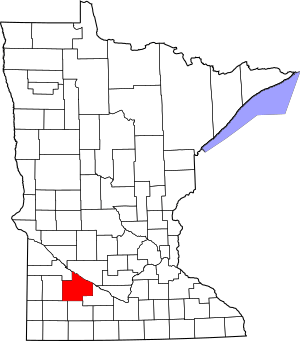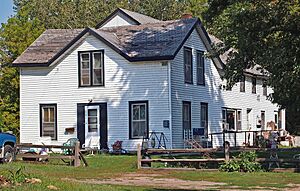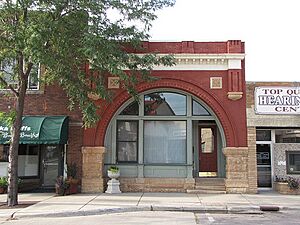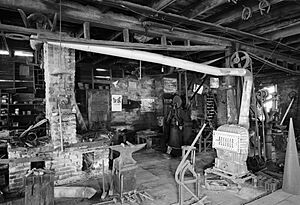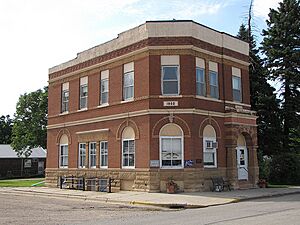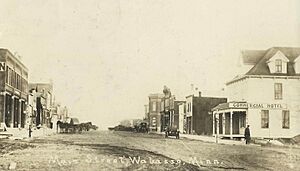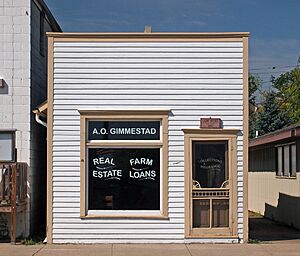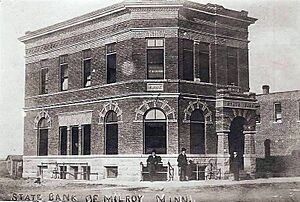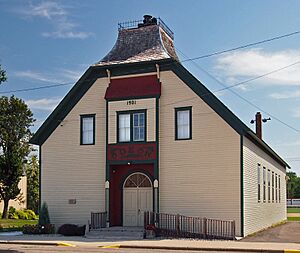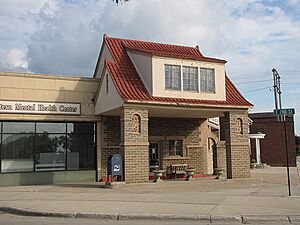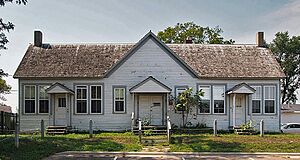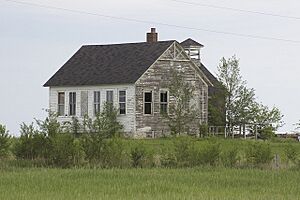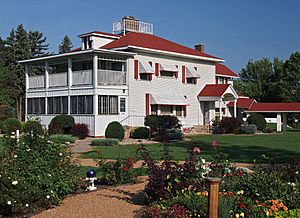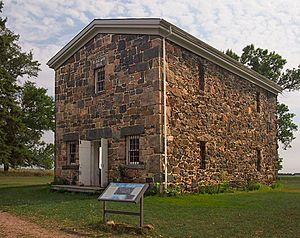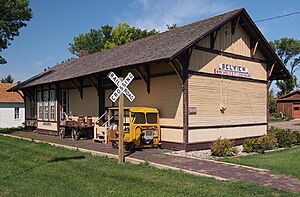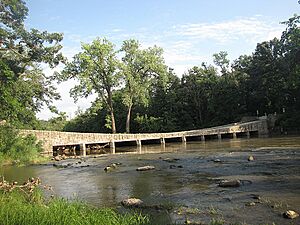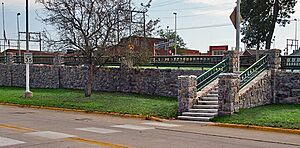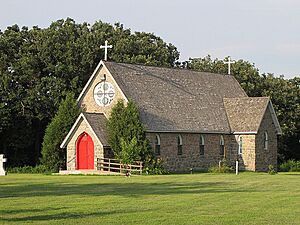National Register of Historic Places listings in Redwood County, Minnesota facts for kids
Have you ever wondered about the oldest and most important buildings and places in your community? In Redwood County, Minnesota, there's a special list called the National Register of Historic Places. This list helps protect and celebrate places that are important to history, architecture, or culture in the United States. Think of it like a hall of fame for buildings, bridges, and other sites!
This article will tell you about 22 amazing places in Redwood County that are on this list. You'll learn about old houses, schools, banks, and even a unique bridge. There were also a few places that used to be on the list but aren't anymore. Let's explore the cool history of Redwood County!
Contents
Cool Historic Places in Redwood County
Here are some of the interesting places in Redwood County that are recognized for their historical importance:
Homes with History
J.A. Anderson House
Located at 402 4th Avenue in Lamberton, this house was built around 1900. It's a fantastic example of a Queen Anne style home in Redwood County. Queen Anne houses often have fancy towers, turrets, and decorative details, making them look like something out of a fairytale!
H.D. Chollar House
You can find this house at 4th and Minnesota Streets in Redwood Falls. Built around 1878, it's the only Italianate style house in Redwood Falls. Italianate homes are known for their tall, narrow windows, wide eaves, and often a square tower. The owner, H.D. Chollar, was also important because he ran a lumber yard, which was a big business back then.
Honner-Hosken House
This historic home is at North and Main Streets in North Redwood. It was built in 1872 by J.S.G. Honner, an important early settler. Later, it belonged to Thomas Hosken, who took over Honner's quarrying business. A quarry is a place where stone is dug out of the ground for building.
Important Buildings for Community Life
Bank of Redwood Falls Building
This small bank building on 2nd Street in Redwood Falls was built around 1885. It stands out because of its large, impressive features, typical of the Richardsonian Romanesque style. This style uses heavy stone and rounded arches, making buildings look strong and grand.
City Blacksmith Shop
In Lamberton, at Douglas Street and 2nd Avenue, you'll find this blacksmith shop built around 1898. It still has much of its original equipment! Blacksmiths were super important in the past, making and repairing metal tools and parts for farmers and others in the community. Today, the Lamberton Area Historical Society takes care of it.
Clements State Bank Building
This bank building in Clements, at 1st and Pine Streets, opened in 1902. It was started by businessmen from Springfield, Minnesota, just like the Milroy State Bank. These banks were important because they helped new towns grow along the railroad lines.
Commercial Hotel
The Commercial Hotel, built in 1901, was located at Front and Main Streets in Wabasso. It was special because it was a rare example of a hotel built by private citizens to serve a small town that was also a railroad stop. It is believed this building has been torn down.
Delhi Coronet Band Hall
This band hall, built in 1896 on 3rd Street in Delhi, was a very important place for the community. It hosted many political and social events as Delhi Township grew. Unfortunately, this building is also likely gone.
Gimmestad Land and Loan Office
On Main Street in Belview, you can see this office building from 1892. It's a rare example of an early office that is still mostly the same as it was built. Land and loan offices were common back then, helping people buy land and get loans, which helped small towns grow.
Milroy State Bank Building
Similar to the Clements State Bank, this building at Superior Street and Euclid Avenue in Milroy was also built in 1902. It was also founded by businessmen from Springfield, Minnesota, showing how people invested in new towns along the railroad.
Odeon Theater
The Odeon Theater on Main Street in Belview is a well-preserved example of a rural theater hall. Built in 1901, it features a simpler version of the Queen Anne architecture style. Imagine watching a play or a silent movie here over a hundred years ago!
Revere Fire Hall
This fire station in Revere, built around 1900 on 2nd Street, is a good example of the special buildings towns needed back then. Fire halls were essential for protecting communities from fires.
Scenic City Cooperative Oil Company
This unique service station, built around 1925 at 2nd and Mill Streets in Redwood Falls, shows when cars started becoming very popular in Redwood County. It's a cool reminder of how transportation changed.
Walnut Grove Creamery Association
In Walnut Grove, at 521 Main Street, stands this building from 1930. It was a cooperative facility where milk was processed. It's a great example of the small creameries that were important for the dairy farming industry in the region in the early 1900s.
Schools and Education
Birch Coulee School
This schoolhouse, located off County Highway 2 south of Morton, was active from 1891 to 1920. It's on the Lower Sioux Indian Reservation and reminds us of a time when the government tried to change Native American cultures through formal education. It's the oldest and best-preserved Native American education building in Minnesota.
District No. 8 School
Found on County Road 70 near Clements, this school from 1908 is a great example of the rural schoolhouses in Redwood County. What makes it special is that it still has its original barn and outhouse!
Redwood Falls Carnegie Library
This library, at 334 S. Jefferson Street in Redwood Falls, was built in 1904. It's a Carnegie library, meaning it was funded by famous businessman Andrew Carnegie, who helped build thousands of libraries across the country. Its outside looks almost exactly as it did when it was built, making it a very important early educational building in Redwood County.
Special Sites and Structures
Chicago and North Western Railroad Depot (Lucan, Minnesota)
This railway station, built in 1902 on 1st Street in Lucan, shows how important railroads were. They helped farmers get their crops to market and were key to where towns were built and how they grew.
Gilfillan Estate
Located near Redwood Falls on Minnesota State Highway 67, this large farm was established in 1882 by Charles Duncan Gilfillan and later his son. They were important in developing St. Paul and Redwood County, and they promoted new farming methods. The farm also has a connection to the history of the Lower Sioux Indian Reservation land. Today, the Redwood County Historical Society manages it.
Lower Sioux Agency
This site at 32469 County Road 2 in Morton was the main federal office for the Lower Sioux Indian Reservation starting in 1853. It was destroyed during the Dakota War of 1862. Now, it's a museum with a restored stone warehouse from 1861, teaching visitors about this important part of history.
Minneapolis and St. Louis Railroad Depot (Belview, Minnesota)
Just like the Lucan depot, this railway station, built in 1892 off Main Street in Belview, highlights the huge role railroads played in helping farms and towns develop in the area.
Ramsey Park Swayback Bridge
You can find this unique bridge in Ramsey Park in Redwood Falls. It was built in 1938 by the Works Progress Administration (WPA), a government program during the Great Depression that created jobs by building public works. Its "swayback" design makes it special.
Redwood Falls Retaining Wall Roadside Development Project
This project, located at the junction of MN 19 and US 71 in Redwood Falls, was built between 1934 and 1936. It's a great example of early roadside development by the Minnesota Department of Highways. It was designed to make roads safer and more beautiful as the state highway system grew.
St. Cornelia's Episcopal Church
This church, at 38378 Reservation Highway 101 near Morton, was built between 1889 and 1891. It was built for a Dakota congregation who were able to return to Minnesota after being exiled following the Dakota War of 1862. It also shows the work of Episcopal missionaries among Native Americans and is a beautiful example of Gothic Revival architecture, a style that looks like medieval churches.
Former Listings
Sometimes, places that were once on the National Register of Historic Places are removed. This usually happens if they are torn down or changed so much that they no longer look like they did when they were important.
Here are a couple of places in Redwood County that used to be on the list:
Lamberton Farmers Elevator
This grain elevator in Lamberton, built in 1916, was unusual because it was made of brick. It was located at 1st Avenue and Douglas Street. Sadly, it fell into disrepair and was torn down by the city in 1989.
Milroy Block
The Milroy Block was a commercial building in Milroy, built in 1902. It was an example of Italianate architecture. Located at Euclid Avenue and Cherry Street, it was torn down in 1998.


